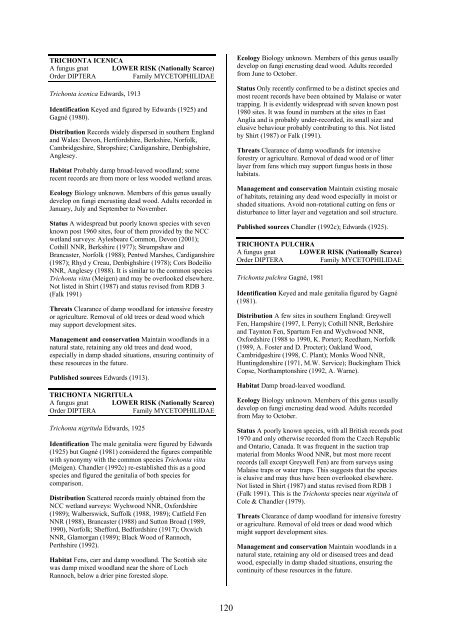Part 2: Nematocera and Aschiza not dealt with by Falk (1991) - JNCC
Part 2: Nematocera and Aschiza not dealt with by Falk (1991) - JNCC
Part 2: Nematocera and Aschiza not dealt with by Falk (1991) - JNCC
You also want an ePaper? Increase the reach of your titles
YUMPU automatically turns print PDFs into web optimized ePapers that Google loves.
TRICHONTA ICENICA<br />
A fungus gnat LOWER RISK (Nationally Scarce)<br />
Order DIPTERA<br />
Family MYCETOPHILIDAE<br />
Trichonta icenica Edwards, 1913<br />
Identification Keyed <strong>and</strong> figured <strong>by</strong> Edwards (1925) <strong>and</strong><br />
Gagné (1980).<br />
Distribution Records widely dispersed in southern Engl<strong>and</strong><br />
<strong>and</strong> Wales: Devon, Hertfordshire, Berkshire, Norfolk,<br />
Cambridgeshire, Shropshire; Cardiganshire, Denbighshire,<br />
Anglesey.<br />
Habitat Probably damp broad-leaved woodl<strong>and</strong>; some<br />
recent records are from more or less wooded wetl<strong>and</strong> areas.<br />
Ecology Biology unknown. Members of this genus usually<br />
develop on fungi encrusting dead wood. Adults recorded in<br />
January, July <strong>and</strong> September to November.<br />
Status A widespread but poorly known species <strong>with</strong> seven<br />
known post 1960 sites, four of them provided <strong>by</strong> the NCC<br />
wetl<strong>and</strong> surveys: Aylesbeare Common, Devon (2001);<br />
Cothill NNR, Berkshire (1977); Strumpshaw <strong>and</strong><br />
Brancaster, Norfolk (1988); Pentwd Marshes, Cardiganshire<br />
(1987); Rhyd y Creau, Denbighshire (1978); Cors Bodeilio<br />
NNR, Anglesey (1988). It is similar to the common species<br />
Trichonta vitta (Meigen) <strong>and</strong> may be overlooked elsewhere.<br />
Not listed in Shirt (1987) <strong>and</strong> status revised from RDB 3<br />
(<strong>Falk</strong> <strong>1991</strong>)<br />
Threats Clearance of damp woodl<strong>and</strong> for intensive forestry<br />
or agriculture. Removal of old trees or dead wood which<br />
may support development sites.<br />
Management <strong>and</strong> conservation Maintain woodl<strong>and</strong>s in a<br />
natural state, retaining any old trees <strong>and</strong> dead wood,<br />
especially in damp shaded situations, ensuring continuity of<br />
these resources in the future.<br />
Published sources Edwards (1913).<br />
TRICHONTA NIGRITULA<br />
A fungus gnat LOWER RISK (Nationally Scarce)<br />
Order DIPTERA<br />
Family MYCETOPHILIDAE<br />
Trichonta nigritula Edwards, 1925<br />
Identification The male genitalia were figured <strong>by</strong> Edwards<br />
(1925) but Gagné (1981) considered the figures compatible<br />
<strong>with</strong> synonymy <strong>with</strong> the common species Trichonta vitta<br />
(Meigen). Ch<strong>and</strong>ler (1992c) re-established this as a good<br />
species <strong>and</strong> figured the genitalia of both species for<br />
comparison.<br />
Distribution Scattered records mainly obtained from the<br />
NCC wetl<strong>and</strong> surveys: Wychwood NNR, Oxfordshire<br />
(1989); Walberswick, Suffolk (1988, 1989); Catfield Fen<br />
NNR (1988), Brancaster (1988) <strong>and</strong> Sutton Broad (1989,<br />
1990), Norfolk; Shefford, Bedfordshire (1917); Oxwich<br />
NNR, Glamorgan (1989); Black Wood of Rannoch,<br />
Perthshire (1992).<br />
Habitat Fens, carr <strong>and</strong> damp woodl<strong>and</strong>. The Scottish site<br />
was damp mixed woodl<strong>and</strong> near the shore of Loch<br />
Rannoch, below a drier pine forested slope.<br />
Ecology Biology unknown. Members of this genus usually<br />
develop on fungi encrusting dead wood. Adults recorded<br />
from June to October.<br />
Status Only recently confirmed to be a distinct species <strong>and</strong><br />
most recent records have been obtained <strong>by</strong> Malaise or water<br />
trapping. It is evidently widespread <strong>with</strong> seven known post<br />
1980 sites. It was found in numbers at the sites in East<br />
Anglia <strong>and</strong> is probably under-recorded, its small size <strong>and</strong><br />
elusive behaviour probably contributing to this. Not listed<br />
<strong>by</strong> Shirt (1987) or <strong>Falk</strong> (<strong>1991</strong>).<br />
Threats Clearance of damp woodl<strong>and</strong>s for intensive<br />
forestry or agriculture. Removal of dead wood or of litter<br />
layer from fens which may support fungus hosts in those<br />
habitats.<br />
Management <strong>and</strong> conservation Maintain existing mosaic<br />
of habitats, retaining any dead wood especially in moist or<br />
shaded situations. Avoid non-rotational cutting on fens or<br />
disturbance to litter layer <strong>and</strong> vegetation <strong>and</strong> soil structure.<br />
Published sources Ch<strong>and</strong>ler (1992c); Edwards (1925).<br />
TRICHONTA PULCHRA<br />
A fungus gnat LOWER RISK (Nationally Scarce)<br />
Order DIPTERA<br />
Family MYCETOPHILIDAE<br />
Trichonta pulchra Gagné, 1981<br />
Identification Keyed <strong>and</strong> male genitalia figured <strong>by</strong> Gagné<br />
(1981).<br />
Distribution A few sites in southern Engl<strong>and</strong>: Greywell<br />
Fen, Hampshire (1997, I. Perry); Cothill NNR, Berkshire<br />
<strong>and</strong> Taynton Fen, Spartum Fen <strong>and</strong> Wychwood NNR,<br />
Oxfordshire (1988 to 1990, K. Porter); Reedham, Norfolk<br />
(1989, A. Foster <strong>and</strong> D. Procter); Oakl<strong>and</strong> Wood,<br />
Cambridgeshire (1998, C. Plant); Monks Wood NNR,<br />
Huntingdonshire (1971, M.W. Service); Buckingham Thick<br />
Copse, Northamptonshire (1992, A. Warne).<br />
Habitat Damp broad-leaved woodl<strong>and</strong>.<br />
Ecology Biology unknown. Members of this genus usually<br />
develop on fungi encrusting dead wood. Adults recorded<br />
from May to October.<br />
Status A poorly known species, <strong>with</strong> all British records post<br />
1970 <strong>and</strong> only otherwise recorded from the Czech Republic<br />
<strong>and</strong> Ontario, Canada. It was frequent in the suction trap<br />
material from Monks Wood NNR, but most more recent<br />
records (all except Greywell Fen) are from surveys using<br />
Malaise traps or water traps. This suggests that the species<br />
is elusive <strong>and</strong> may thus have been overlooked elsewhere.<br />
Not listed in Shirt (1987) <strong>and</strong> status revised from RDB 1<br />
(<strong>Falk</strong> <strong>1991</strong>). This is the Trichonta species near nigritula of<br />
Cole & Ch<strong>and</strong>ler (1979).<br />
Threats Clearance of damp woodl<strong>and</strong> for intensive forestry<br />
or agriculture. Removal of old trees or dead wood which<br />
might support development sites.<br />
Management <strong>and</strong> conservation Maintain woodl<strong>and</strong>s in a<br />
natural state, retaining any old or diseased trees <strong>and</strong> dead<br />
wood, especially in damp shaded situations, ensuring the<br />
continuity of these resources in the future.<br />
120
















